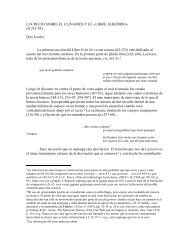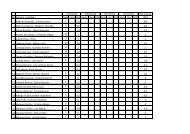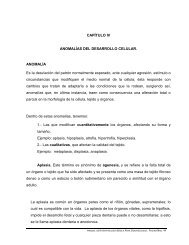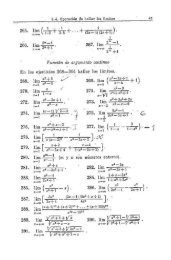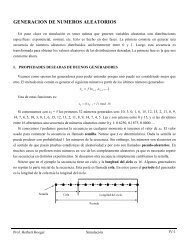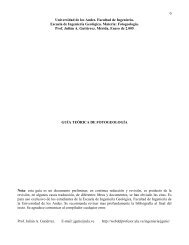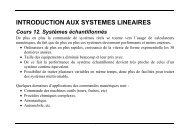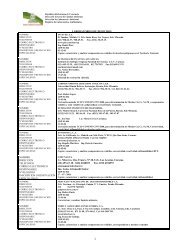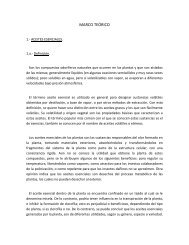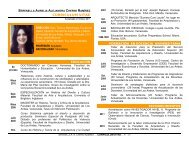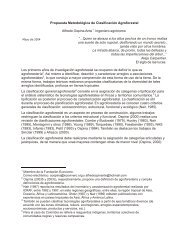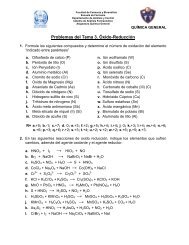Macrocyclic Ligands - Web del Profesor
Macrocyclic Ligands - Web del Profesor
Macrocyclic Ligands - Web del Profesor
You also want an ePaper? Increase the reach of your titles
YUMPU automatically turns print PDFs into web optimized ePapers that Google loves.
mechanism is the assumption that coordination geometry<br />
preferences can be suddenly changed at some point along<br />
a series of ligands where gradual changes in the ligand<br />
framework are made. Because these changes can occur at<br />
different points for different metal ions, discrimination can<br />
be achieved. A particularly appealing aspect of the mixed<br />
donor aza–oxa systems is the lower ligand field which they<br />
provide, which then tends to minimize spin state changes.<br />
These systems are treated in a comprehensive review of<br />
O3N2, O2N3, and other pentadentate macrocycles with N, O,<br />
S heteroatoms. 104<br />
Examples of the use of synthetic mixed donor macrocycles<br />
in heavy metal ion separations are found in the discrimination<br />
of silver from lead. A number of studies indicate that<br />
the inclusion of sulfur in macrocyclic sequestering agents<br />
shifts the discrimination to silver. 104 An example of this<br />
is seen with (57) and (58). For the aza–oxa macrocycle<br />
(57) the log K is 5.9 for both silver and lead ions,<br />
while the thia-incorporated ligand (58) complexes silver<br />
more efficiently (log K = 9.9) compared to lead (log<br />
K = 5.7). 106,107<br />
NH<br />
O O<br />
HN<br />
NH<br />
S S<br />
O<br />
O<br />
(57) (58)<br />
HN<br />
The larger mixed aza–oxa, aza–thia, and aza–and<br />
oxa–phospha macrocycles are noted for their ability to<br />
complex more than one metal ion and to alter the magnetic<br />
properties of bimetallic complexes. 108–110 An example of<br />
tri-metal coordination is the tricopper complex of a 27member<br />
ring system (59). 108 A classic series of dicopper<br />
complexes which illustrates the influence of donor atoms<br />
on magnetism are the dicopper structures (60)–(62). 110 The<br />
magnetic properties were found to be extremely dependent<br />
on the mode of azide coordination, which is thought to be<br />
influenced by the orientation of the orbitals on the metal ions.<br />
In complex (60), the two copper ions are ferromagnetically<br />
coupled with a triplet ground state; in (61), the metal ions<br />
are antiferromagnetically coupled; and in (62), the two copper<br />
ions are not coupled.<br />
4.4.2 Cryptands<br />
Cryptands (15) are noted for their highly selective<br />
complexation of alkaline earth metal ions, and for their<br />
ring size–metal ion match ability. 5 The thermodynamic<br />
properties of these macrocycles have been extensively<br />
investigated, and results indicate that the high stability of the<br />
N<br />
H<br />
N<br />
H<br />
O<br />
Cu<br />
HOH O<br />
HN Cu Cu NH<br />
HN NH<br />
O<br />
(59)<br />
H<br />
N<br />
N3<br />
O<br />
N3<br />
H<br />
N<br />
HN Cu Cu<br />
N3<br />
N<br />
H<br />
O<br />
(61)<br />
N<br />
H<br />
N 3<br />
NH<br />
MACROCYCLIC LIGANDS 15<br />
HN<br />
N 3<br />
O<br />
Cu<br />
O<br />
O<br />
N<br />
N<br />
N<br />
N<br />
N<br />
N<br />
O<br />
(60)<br />
S<br />
N3 N N N<br />
S<br />
O<br />
Cu<br />
O<br />
S<br />
S<br />
N 3<br />
NH<br />
HN Cu Cu NH<br />
N<br />
N N N3<br />
(62)<br />
bicyclic macrocycles compared to their monocyclic analogs is<br />
enthalpic in origin. 88<br />
4.4.3 Compartmental <strong>Ligands</strong><br />
Compartmental ligands (16) provide extensive opportunities<br />
for multiple metal ion complexation. An example of a<br />
mixed donor ligand incorporating different metal ions is the<br />
macrocyclic trinucleating ligand (63), which is capable of<br />
complexing two ‘soft’ donor metal centers in addition to a<br />
‘hard’ alkali or alkaline earth metal. 111<br />
4.5 Oxa Macrocycles<br />
4.5.1 Crown Ethers<br />
In the crown ethers (18) the interactions between the ligand<br />
and metal ion are considered to be more electrostatic in nature,<br />
rather than the covalent binding observed for the transition<br />
metal complexes of the aza, thia, and phospha macrocycles.<br />
The thermodynamic properties of these macrocycles have<br />
been extensively studied, with numerous reviews covering<br />
complexation, selectivity, and structural aspects, some with<br />
extensive tables of thermodynamic data. 69,70,112–119 Considerable<br />
efforts have been made to correlate the interrelationship<br />
between cavity size of the macrocycles and stability of alkali<br />
and alkaline earth metal complexes. From X-ray and CPK<br />
mo<strong>del</strong>s, cavity radii are determined as 0.86–0.92 ˚A for 15crown-5<br />
(64), 1.34–1.43 ˚A for 18-crown-6 (65), and about<br />
1.7 ˚A for 21-crown-7 (66). 69 For complex formation between<br />
the alkali metal ions and 18-crown-6, the maximum stability



